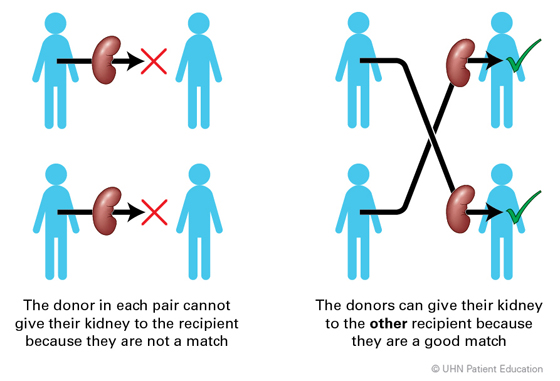To Know Your Treatment Options
To Know Your Treatment Options / Step 1: Making an Informed Decision / Types of Kidney Transplants
Living Donor Transplant
When a living person donates one of their kidneys to a recipient. The donor may or may not know the recipient. The donor does not have to be a family member of the recipient.
- To be a living donor you must be 18+ and have normal kidney function.
- These medical conditions may prevent you from becoming a donor: high blood pressure, diabetes, cancer, HIV, hepatitis or acute infection & serious mental health conditions that require treatment.
Living Donor Transplant
1. Directed donation
A kidney donation that is designated to a particular individual. In this type, the donor directs the organ to a specific recipient for transplant. This is the most common type of living donation and it usually happens between close blood relatives such as a child, a parent or a sibling. Close personal ties, such as those with a spouse, friend, or coworker, can also result in this type of donation.
2. Non-directed donation
A kidney donation that is not designated to a particular individual but to someone who is in need of one. In nondirected living-donor organ donation, the donor does not name the recipient of the donated organ. The match is based solely on medical needs and blood type compatibility.
3. Paired donations
This type of donation involves a “swap”, where the donors and recipients donate or receive a kidney based on their compatibility. The donor of one pair will donate their kidney to the recipient of the other pair and vice-versa. This ensures that each recipient is receiving a compatible kidney.

Advantages of Living Donor Kidney Transplant
Living donations between genetically similar family members may reduce the risk of rejection
- Living kidneys usually function immediately while the deceased kidney may take time (dialysis will need to happen until then)
- Less time spent on a waiting list, which could prevent possible complications and deterioration of the health of the recipient
- Potential avoidance of dialysis if it has not been initiated
- Better short- and long-term survival rates
- The transplant may be scheduled in advance once the donor is approved as opposed to an unscheduled, emergency transplant procedure with a deceased donor kidney
Deceased Donor Kidney Transplant
The kidney of a person who has recently died in a hospital and is subsequently placed into the recipient. The family of the donor has to consent to the donation.
- The donor is usually in the same geographic region as the recipient
- The kidney is either kept on ice or in a machine that feeds it with oxygen and nutrients to survive
- It is important to keep in mind that the demand for deceased donors exceeds the supply
- If there is no living kidney donor or if you wish for a deceased donor you will be placed on a waiting list
- Depending on your location, age, biological compatibility and timing, your wait for a deceased donor could be anywhere from several months to years.
Now that you know what kidney transplantation is and the different types. It is time to move on to Step 2: Referral & Evaluation
